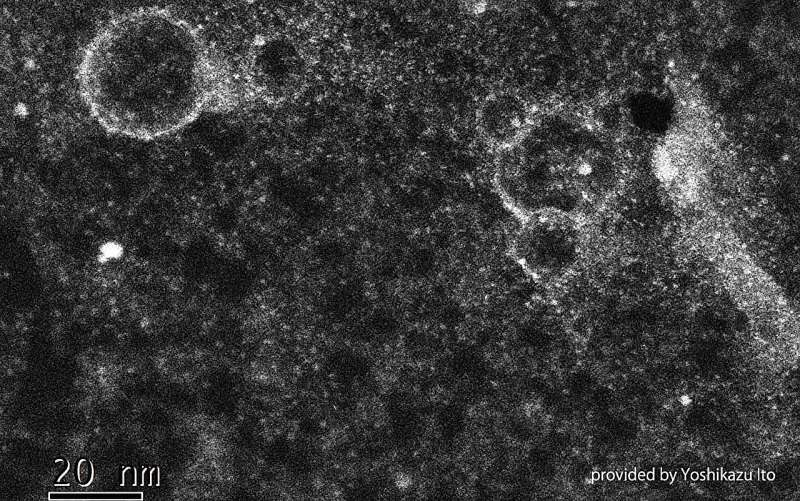
A research team led by the University of Tsukuba has successfully developed a new method that can prevent the crossover of large fuel molecules and suppress the degradation of electrodes in advanced fuel cell technology using methanol or formic acid.
The successful sieving of the fuel molecules is achieved via selective proton transfers due to steric hindrance on holey graphene sheets that have chemical functionalization and act as proton-exchange membranes.
For realizing carbon neutrality, the demand for the development of direct methanol/formic acid-fuel cell technology has been increasing. In this technology, methanol or formic acid is used as an e-fuel for generating electricity.
The fuel cells generate electricity via proton transfer; however, conventional proton-exchange membranes suffer from the “crossover phenomenon,” where the fuel molecules are also transferred between anodes and cathodes. Thereafter, the fuel molecules are unnecessarily oxidized and the electrodes are deactivated.
In a study, published in Advanced Science, researchers developed a new proton-exchange membrane comprising graphene sheets with 5–10 nm-diameter holes, which are chemically modified with sulfanilic functional groups affording sulfo groups around the holes.
Owing to steric hindrance by the functional groups, the graphene membrane successfully suppresses the crossover phenomenon by blocking the penetration of the fuel molecules while maintaining high proton conductivity, maybe for the first time, according to the researchers.
To date, conventional approaches for inhibiting fuel-molecule migration involved an increase of the membrane thickness or sandwiching two-dimensional materials, which in turn reduced the proton conductivity.
In this study, the researchers investigated structures that inhibit the migration of fuel molecules through electro-osmotic drag and steric hindrance. Consequently, they found that the sulfanilic-functionalized graphene membrane can remarkably suppress electrode degradation compared with the commercially-available Nafion membranes while maintaining the proton conductivity required for fuel cells.
Furthermore, simply pasting the graphene membrane onto a conventional proton-exchange membrane can suppress the crossover phenomenon. Thus, this study contributes to the development of advanced fuel cells as a new alternative for hydrogen-type fuel cells.
More information:
Samuel Jeong et al, Suppression of Methanol and Formate Crossover through Sulfanilic‐Functionalized Holey Graphene as Proton Exchange Membranes, Advanced Science (2023). DOI: 10.1002/advs.202304082
Journal information:Advanced Science
Provided by
University of Tsukuba

READ MORE
Tiny llama nanobodies neutralize different noroviruses—can they improve human anti-viral therapies?
Comparison of M4-GII.4 P-domain complex with representative GII.4-mAb or GII.4-nanobody complexes. a–c Superimposition of the [...]
Bioinspired self-assembled colloidal collectives of active matter systems
Three-dimensional drifting control of magnetic colloidal collectives. (A) The schematic diagram shows the motion mechanism [...]
Space
The Seven Most Amazing Discoveries We’ve Made by Exploring Mercury Only two robotic missions have [...]
‘Uncharted territory’: El Niño to flip to La Niña in what could be the hottest year on record
A quick flip from El Niño to La Niña is coming soon, but what does [...]
Researchers investigate new physical phenomena on the nanoscale with microstructured fibers
The concept of single antiresonant-element (ARE) fiber-assisted nanoparticle-tracking analysis (FaNTA) applied to track sub-10-nm nano-objects. [...]
This High Schooler Invented an A.I.-Powered Trap That Zaps Invasive Lanternflies
ArTreeficial is a solar-powered, self-cleaning, artificial-intelligence-driven “tree” that entices the spotted lanternfly and eliminates the [...]
Nanobubbles provide pathway to build better medical devices
Credit: AI-generated image Researchers from the University of Sydney Nano Institute and School of Chemistry [...]
The Moon Was Formed in a Smashup Between Earth and a Near Twin
When young planets collide. Hagai Perets The moon was born in the collision of a [...]